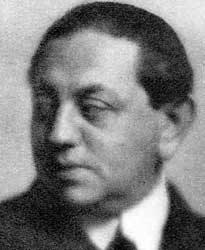This articleneeds additional citations forverification.(November 2009) |
Paul Leni(bornPaul Josef Levi;8 July 1885 – 2 September 1929) was a German filmmaker and a key figure inGerman Expressionism,makingHintertreppe(1921) andWaxworks(1924) in Germany, andThe Cat and the Canary(1927),The Chinese Parrot(1927),The Man Who Laughs(1928), andThe Last Warning(1928) in the United States.
Paul Leni | |
|---|---|
 | |
| Born | Paul Josef Levi 8 July 1885[1] |
| Died | 2 September 1929(aged 44)[1] |
| Nationality | German |
| Occupation(s) | Film director,art director |
| Years active | 1913–1929 |
| Notable work | |
| Movement | German Expressionism |
Life and career
editPaul Josef Levi was born to a Jewish family[2]inStuttgart.He became an avant-garde painter at the age of 15, he studied at Berlin's Academy of Fine Arts, and subsequently worked as a theatrical set designer, working for a number of theatres in Berlin (but not withMax Reinhardt).
In 1913, he started working in the German film industry designing film sets and/or costumes for directors such asJoe May,Ernst Lubitsch,Richard Oswald,andE. A. Dupont.
During World War I, Leni started directing as well with films such asDer Feldarzt(Das Tagebuch des Dr. Hart,1917),Patience(1920),Die Verschwörung zu Genua(1920/21) andBackstairs(1921). In 1923 he participated in the creation of the theater cabaret-cafe Gondola in Berlin.Waxworks(1924) was planned as a four-part omnibus feature, but the last part was not shot when money ran out. He also made a series of unusual shortanimatedfilmsRebus-Film Nr. 1–8,which were filmedcrossword puzzles.
Leni designed short prologues for festive film premieres in Berlin cinemas, such as Lubitsch'sForbidden Paradise(1924),Herbert Brenon'sPeter Pan(1924), and E. A. Dupont'sVariety(1925).
In 1927, he acceptedCarl Laemmle's invitation to become a director atUniversal Studiosand moved to Hollywood. There Leni made a distinguished directorial debut withThe Cat and the Canary(1927), an adaptation ofJohn Willard's stage play. The film had a great influence over Universal's later classic "haunted house"horror series, and was subsequently remade several times, notably in 1939 withBob Hope.The following year he directed the big budgetThe Man Who Laughs(based on the novel byVictor Hugo), one of the most visually stylized of late period silent films.
His final film wasThe Last Warning,envisioned as a companion film forThe Cat and the Canarydue to its predecessor's popularity.[3]Leni died inLos Angeleson 2 September 1929, ofsepsisbrought on by an untreated tooth infection,[4]only eight months after its release.[5]He was 44.
Filmography
editGerman films
editAs art director
- Ein Ausgestoßener(1913) (dir:Joe May)
- The Man in the Chot of AMSA ZUBAIR(1914) (dir: Joe May)
- The Armoured Vault(1914) (dir: Joe May)
- Der Katzensteg(1915) (dir:Max Mack)
- Der Blusenkönig(1917) (dir:Ernst Lubitsch)
- The Ring of Giuditta Foscari(1917)
- Veritas Vincit(1919) (dir: Joe May)
- Intoxication(1919) (dir: Ernst Lubitsch)
- The White Peacock(1920) (dir:E. A. Dupont)
- The Vulture Wally(1921) (dir: E. A. Dupont)
- Lady Hamilton(1921) (dir:Richard Oswald)
- Children of Darkness(1921)
- Frauenopfer(1921/22) (dir:Karl Grune)
- Tragedy of Love1922) (4 parts, dir: Joe May)
- The Countess of Paris(1923)
- The Farmer from Texas(1925) (dir: Joe May)
- The Wife of Forty Years(1925) (dir: Richard Oswald)
- Dancing Mad(1925) (dir:Alexander Korda)
- Manon Lescaut(1926) (dir:Arthur Robison)
- Einspänner Nr. 13 / Fiaker Nr. 13(1926) (dir:Michael Kertész)
- The Golden Butterfly(1926) (dir: Michael Kertész)
- Maytime(1926) (dir:Willi Wolff)
As director (and art director)
- 1917Dr. Hart's Diary/ Der Feldarzt / Das Tagebuch des Dr. Hart
- 1917Prima vera
- 1917Dornröschen
- 1918The Mystery of Bangalore
- 1919The Platonic Marriage
- 1919Prince Cuckoo
- 1920Patience
- 1920/21The Conspiracy in Genoa
- 1921Hintertreppe(dir withLeopold Jessner)
- 1924Waxworks(Das Wachsfigurenkabinett)
- 1925/26Rebus-Film Nr. 1–8(series of short films)
Universal Studio films
edit- The Cat and the Canary(1927)
- The Chinese Parrot(1927)
- The Man Who Laughs(1928)
- The Last Warning(1928/29)
References
edit- ^abcd"BFI database: Paul Leni".bfi.org.uk.Archived fromthe originalon 17 November 2016.Retrieved16 November2016.
- ^Brook, Vincent (2009).Driven to Darkness: Jewish Emigre Directors and the Rise of Film Noir.Rutgers University Press. p. 256.ISBN978-0813548333.
- ^Atkinson, Michael."The Last Warning".silentfilm.org/.Archived fromthe originalon 17 November 2016.Retrieved16 November2016.
The kind of party we're in for was immediately familiar to audiences in 1929 because of the intense popularity two years earlier of Leni's The Cat and the Canary—to which The Last Warning is devised to be a companion film, almost a redux.
- ^Landazuri, Margarita."The Cat And The Canary".silentfilm.org/.Archived fromthe originalon 18 December 2017.Retrieved16 November2016.
He died on September 2, 1929, of blood poisoning caused by a neglected tooth infection. He was 44 years old.
- ^Atkinson, Michael."The Last Warning".silentfilm.org/.Archived fromthe originalon 17 November 2016.Retrieved16 November2016.
was the final film for the illustrious Leni who died eight months after its release of blood poisoning at the age of forty-four.
Further reading
edit- Schneider, Steven Jay, ed. (2007).501 Movie Directors.London: Cassell Illustrated. p. 33.ISBN9781844035731.OCLC1347156402.